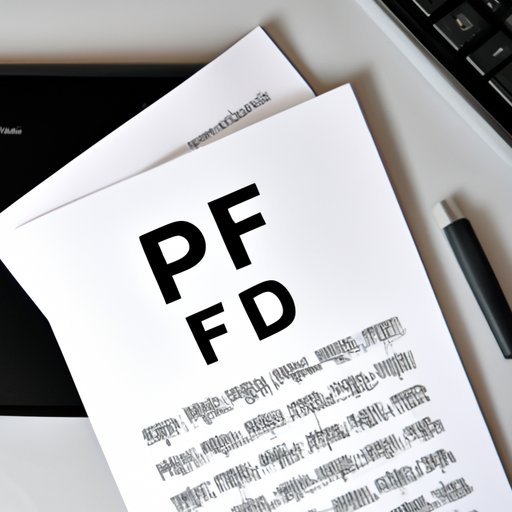
I. Introduction
PDF (Portable Document Format) is one of the most popular document formats used today, known for its document security and stability. However, it can sometimes be challenging to edit the content of a PDF file. That’s where converting a PDF to Word comes in. In this article, we’ll explore the many methods for PDF to Word conversion, including software tools and online converters.
II. Step-by-Step Guide
Here’s a step-by-step guide to converting a PDF to Word:
Step 1: Choosing a software or online tool for conversion
First, you need to choose a tool that can convert PDF to Word. Some popular online conversion tools include Adobe Acrobat, Smallpdf, and Nitro PDF. Some software tools like UniPDF, PDFelement, and Able2Extract also convert PDF to Word.
Step 2: Uploading the PDF file
The next step is uploading the PDF file to the conversion tool. The process may vary depending on the tool, but most require you to simply drag and drop the PDF file into a designated box on the website or software.
Step 3: Selecting the output format
After uploading the PDF file, you need to select the output format, which is typically “Word Document” or “.docx” file. Some converters also offer other formats like RTF or TXT.
Step 4: Downloading the new Word document
Finally, you’ll be provided with the converted Word document. You can then download, view, and edit it as needed.
Here is an example of converting a PDF to Word using Smallpdf:

III. Comparison of Conversion Tools
Now, let’s compare some of the most popular online and software PDF to Word conversion tools. Here are some factors to consider when selecting a tool:
- Ease of use: Some conversion tools are more user-friendly than others.
- Cost: Some conversion tools are completely free, while others charge a fee.
- Speed: Some conversion tools can convert files faster than others.
- Accuracy: Some conversion tools can better preserve the original format of the PDF file than others.
Here is a comparison chart for some of the most popular conversion tools:
| Conversion Tool | Ease of Use | Cost | Speed | Accuracy |
|---|---|---|---|---|
| Adobe Acrobat | Easy | Paid | Fast | High |
| Smallpdf | Very Easy | Free for limited use, Paid for pro version | Fast | Medium |
| Nitro PDF | Easy | Free for limited use, Paid for pro version | Medium | Medium |
| UniPDF | Easy | Free | Slow | Medium |
| PDFelement | Easy | Paid | Fast | High |
| Able2Extract | Easy | Paid | Fast | High |
Based on the comparison table, if you’re looking for a free and very easy-to-use tool that converts files quickly, Smallpdf would be a great choice. If you want a tool that has high accuracy, and don’t mind paying, Adobe Acrobat and PDFelement could be your best bet.
IV. Tips and Tricks for Conversion
Here are some tips and tricks to make your PDF to Word conversion process smoother and faster:
- Optimize the PDF file: Before converting the PDF to Word, optimize the file by compressing the images and removing any unwanted graphics to reduce the file size.
- Ensure the PDF is not locked: If a PDF is locked, it may not convert correctly. Make sure the PDF is unlocked or the password is known before converting.
- Use a fast and stable internet connection: Using a slow or unstable internet connection can cause the conversion process to lag or stop.
- Use keyboard shortcuts: Some conversion tools offer keyboard shortcuts to help speed up the process. For example, Adobe Acrobat offers the “Ctrl+Shift+T” shortcut to convert PDF to Word.
V. Overview of Different Conversion Methods
There are different methods for PDF to Word conversion, including using online tools, using software tools and using Microsoft Word.
Online tools are often free to use, require no installation and can be accessed from anywhere with an internet connection. Software tools can offer better features like higher accuracy and security, and Microsoft Word offers in-built PDF to Word conversion for convenience.
Here are some pros and cons of each method:
| Method | Pros | Cons |
|---|---|---|
| Online Tools | Free, no installation needed, accessible anywhere with internet connection. | Some may have limited features, not as secure as software tools or Microsoft Word. |
| Software Tools | Higher accuracy and security, better features, work offline. | Sometimes requires installation and may come with a cost. |
| Microsoft Word | In-built feature, convenient for those with Microsoft Word subscription. | May not offer as high accuracy as software tools. |
Overall, choosing the best method depends on your specific needs. If you only need to convert PDF to Word occasionally and don’t want to pay, then online tools like Smallpdf is your best choice. If you want higher accuracy and better security, then a software tool like PDFelement may be more suitable.
VI. Application of Conversion in Different Scenarios
PDF to Word conversion can be necessary in various scenarios, such as education, employment, and legal documentation.
For students, converting PDF files to Word allows them to edit research papers, lecture notes, and assignments easily. For employees, converting PDF forms and documents to Word can make it easier to customize and fill in forms. For legal professionals, converting PDF files can make searches faster, easier, and less expensive.
VII. Conclusion
In conclusion, converting PDF to Word can be a valuable tool in the modern world. By following the step-by-step guide and tips provided in this article, readers can select the best methods suited to their specific needs and situations. Remember to always optimize the PDF file before conversion and use reliable and fast internet connections. With these tips, anyone can easily convert PDF files to Word.





